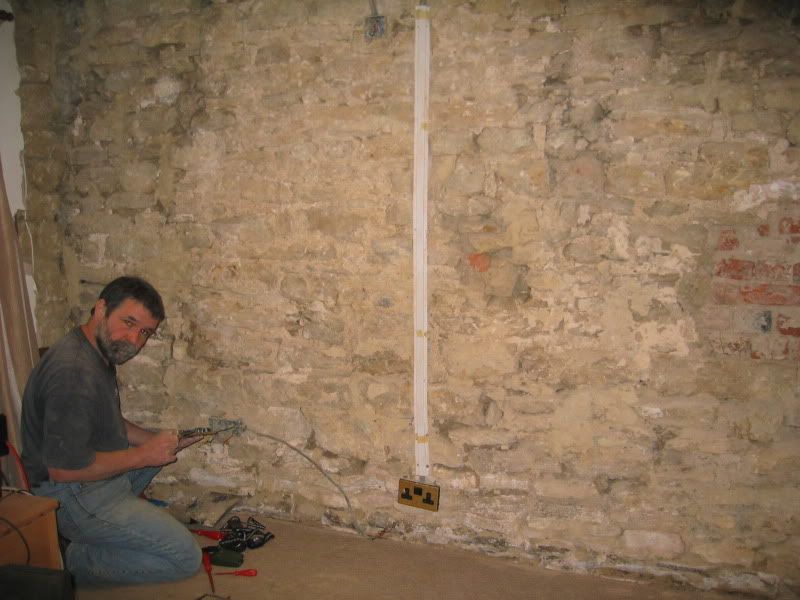The end walls of our house are of 1850s rubble and mud construction and are not in fantastic nick. The stone is the worst possible sandstone and there isn't enough mud holding it together. Looking around neighbouring properties there are signs of failures everywhere and due to the differing construction styles, I would guess that one or other of our walls fell down at some point. The wall I'm working on at the moment is top heavy (50% 300mm, 50% 600mm thick at the bottom, all 600mm thick at the top) and is of course clad on both sides with cement. As is common (I believe) with walls like this, the wall is faced on either side with the better stone with the centre being filled with rubble. Unfortunately there is some signs of the two layers delaminating with a bit of a bulge on the outside though this may due to the results of the chimney being mucked about in the past. Due to the layer of cement on the outside, I can't tell.
This afternoons job was to remove the woodchip wallpaper from the inside of the wall upstairs. It is somewhat satisfying to remove woodchip with a hammer and bolster.

I've now exposed some of the stone.

Note how well the cement has stuck to the stone (it hasn't and basically peeled off though it was hard work as it was thick. At least there is some advantage of having such rubbish stone.)
In various sections there are large voids between the stones as can be seen here:

The crowbar is 450mm long so the void goes most of the way through the wall. (I'm quietly proud of the fact that I've managed to break a crowbar...)
As I have done elsewhere, the plan is to clean the wall up and repoint in lime rather than mud. I will also attempt to fill in as much of the voids as I can so as to attempt to tie the different parts together. Lime is awful in tension so I was thinking it would be sensible to reinforce it with stainless steel wall ties and stainless steel rods / nuts and washers where possible.





Can anybody see any problems with doing this or have a better idea? Currently I don't have easy access to the other side of the wall so ideas that require this, though welcome, would have to wait a while.
In the longer term, we want to build an extension on the other side of this wall which I intend to design so it also acts as a large buttress for this wall but that is a while off. In the mean time is seems sensible to reinforce whilst I have the chance. All comments very welcome.
This afternoons job was to remove the woodchip wallpaper from the inside of the wall upstairs. It is somewhat satisfying to remove woodchip with a hammer and bolster.

I've now exposed some of the stone.

Note how well the cement has stuck to the stone (it hasn't and basically peeled off though it was hard work as it was thick. At least there is some advantage of having such rubbish stone.)
In various sections there are large voids between the stones as can be seen here:

The crowbar is 450mm long so the void goes most of the way through the wall. (I'm quietly proud of the fact that I've managed to break a crowbar...)
As I have done elsewhere, the plan is to clean the wall up and repoint in lime rather than mud. I will also attempt to fill in as much of the voids as I can so as to attempt to tie the different parts together. Lime is awful in tension so I was thinking it would be sensible to reinforce it with stainless steel wall ties and stainless steel rods / nuts and washers where possible.





Can anybody see any problems with doing this or have a better idea? Currently I don't have easy access to the other side of the wall so ideas that require this, though welcome, would have to wait a while.
In the longer term, we want to build an extension on the other side of this wall which I intend to design so it also acts as a large buttress for this wall but that is a while off. In the mean time is seems sensible to reinforce whilst I have the chance. All comments very welcome.


